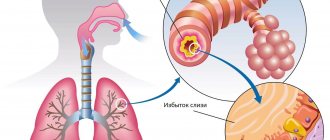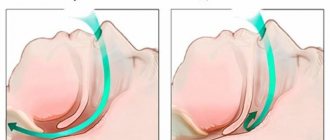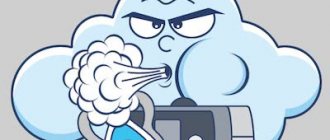Attention!
The information in the article is for reference only and cannot be used for self-diagnosis or self-medication. To decipher the test results, contact a specialist.
There is no such person who has never suffered from bronchitis in his life. It affects people of any age. In adults, if bronchitis develops, it is mild and does not have any health consequences.
Severe obstructive bronchitis most often affects children. The younger the child, the more complex the disease. It is less treatable. Sometimes it takes on a rapid course that threatens the baby’s life.
Obstructive bronchitis, what is it?
Obstructive bronchitis is classified as an inflammatory lesion of the bronchial tree. It affects the mucous membrane lining the inside of the bronchi. Edema narrows the lumen of these structures. Inflammation during bronchitis spreads throughout the entire thickness of the bronchial wall. The function of the ciliary epithelium is impaired.
The disease occurs with symptoms of obstruction, which are expressed in impaired bronchial patency. In children, obstructive bronchitis occurs with attacks of unproductive cough, which is accompanied by noisy whistling breathing.
Such patients are characterized by forced expiration, rapid breathing and distant wheezing. Obstructive bronchitis in children develops at any age. More often than other age groups, it affects children aged six months to 5 years.
The disease is more often registered in children with allergies, weakened immunity and the presence of a genetic predisposition, frequent and prolonged viral respiratory infections. The number of cases of obstructive bronchitis in children is steadily increasing.
Causes of bronchitis
Primary obstructive bronchitis in children is often caused by viruses. The following pathogens affect the bronchial tree:
- parainfluenza virus type 3;
- respiratory syncytial virus;
- enterovirus;
- influenza viruses;
- adenoviruses;
- rhinovirus.
Often the manifestation of obstructive bronchitis in a child is preceded by a cold. The disease is repeatedly caused by other pathogens of persistent infections, which include:
- chlamydia;
- mycoplasma;
- herpesvirus;
- pathogens of whooping cough, parawhooping cough;
- cytomegalovirus;
- mold fungi.
Often, with repeated cases, the opportunistic microflora of the respiratory tract is activated. Allergic reactions play a significant role in the development of bronchial inflammation in children. Relapses of obstructive bronchitis are facilitated by infection with worms and foci of chronic infection (sinusitis, tonsillitis, caries). Factors that provoke the development of exacerbations include:
- physical fatigue;
- hypothermia;
- neuropsychic stress;
- congenital failure of protective barriers;
- unfavorable climate;
- poor environmental stop;
- decreased immunity;
- lack of vitamins.
Passive smoking, as well as irritation of the ciliary epithelium by dust particles and chemicals, play an important role in the development of obstructive bronchial inflammation in children.
ethnoscience
Treatment of obstructive bronchitis with folk remedies does not have evidence-based therapeutic results. And the use of mustard plasters, applications with honey, as well as inhalations with herbs and essential extracts for warming purposes can intensify the phenomena of bronchial obstruction. Complications of the disease:
- Pneumonia, bronchopneumonia
- Chronication of the inflammatory process
- Bronchial asthma
Prevention of obstructive bronchitis:
- Timely treatment and prevention of acute respiratory diseases.
- Vaccination against influenza, Haemophilus influenzae, pneumococcal infection. Premature babies are also vaccinated against respiratory infections.
- Sanitation of foci of chronic inflammation in the oro- and nasopharynx.
- Quitting smoking during pregnancy, in the presence of the child.
- Carrying out general strengthening activities. Spa treatment.
Elimination of allergic background, reduction of allergic readiness.
Pathogenesis of obstructive bronchitis in children
The pathogenesis of the disease has a complex structure. When a virus invades, inflammatory infiltration of the mucous membrane lining the bronchi occurs. Various groups of leukocytes migrate in large numbers in its tissue. Inflammatory mediators are released - histamine, prostaglandin, cytokines. Edema of the bronchial wall develops.
Then the smooth muscle fibers in the wall of the bronchi contract, causing bronchospasm to develop. Goblet cells activate the secretion of bronchial secretions. Mucus has increased viscosity. A disorder of the ciliated epithelium occurs. Mucociliary insufficiency develops. The process of coughing up mucus is disrupted.
The lumen of the respiratory tract is blocked by bronchial secretions. This creates ideal conditions for the proliferation of the bronchitis pathogen. The submucosal and muscular layer of the bronchi is exposed to inflammation. Peribronchial interstitial tissue is included in the process. Lung tissue is not involved in inflammation.
Classification and stages of development of obstructive bronchitis in children
There are three forms of obstructive bronchitis - bronchiolitis, acute and recurrent. Bronchiolitis often affects children under 2 years of age. This is how their body responds to the introduction of rhinovirus or respiratory syncytial infection. It is preceded by a mild ARVI. As the condition worsens, respiratory and heart failure develops. With this form, characteristic moist, fine-bubble wheezing appears on inhalation and exhalation.
Acute bronchial obstruction most often occurs in children aged three to five years. It is caused by parainfluenza and influenza viruses, adenovirus. First, the temperature rises to high numbers. Other symptoms of ARVI appear. Then manifestations of respiratory failure increase. The child has difficulty breathing. The muscles of the neck and shoulders are involved in the breathing process. Whistling sounds occur when exhaling. Exhalation becomes difficult and lengthens.
Recurrent obstructive bronchitis occurs at any age. It is caused by: mycoplasma, cytomegalovirus, herpes virus, Epstein-Barr virus. Bronchial obstruction increases gradually. This occurs at normal or low-grade fever. Nasal congestion, runny nose and infrequent coughing are noted. Shortness of breath is moderate. The general condition is almost unaffected. According to the course of the disease, the following forms are distinguished: acute, protracted, recurrent and continuously relapsing.
Symptoms
A symptom such as cough with phlegm most often occurs in the morning, during the transition from a state of rest to physical activity, or when leaving a warm room into the cold. Outside of a bacterial exacerbation of obstructive bronchitis, the sputum is mucous; with superinfection, the symptoms are mucopurulent or purulent. Such a symptom as shortness of breath during physical exertion increases gradually. This symptom of obstructive bronchitis increases with infectious exacerbation of obstructive bronchitis. Gradually, the patient notices symptoms of difficulty in exhalation, first after significant physical exertion or during forced exhalation, later during normal exercise and even at rest. Signs of obstructive bronchitis appear: distant dry wheezing or whistling, audible or palpable when you apply your palm to the chest. Also, during the period of infectious exacerbation of obstructive bronchitis, low-grade body temperature, fatigue, sweating, as well as pain in various muscle groups associated with their overstrain when coughing are noted.
Symptoms of obstructive bronchitis in children
At the onset of the disease, the clinical picture is dominated by manifestations of ARVI. Dyspeptic symptoms are possible in small children. Bronchial obstruction often occurs on the first day of illness. Bronchitis is manifested by the following symptoms:
- increase in respiratory rate (up to 60 per minute);
- prolongation of exhalation;
- dyspnea;
- breathing is noisy, wheezing;
- auxiliary muscles are involved in the act of breathing;
- the anteroposterior size of the chest increases;
- flaring wings of the nose;
- cough with scant sputum, paroxysmal in nature;
- sputum discharge is difficult;
- pale skin;
- cyanosis of the lips;
- cervical lymphadenitis.
Bronchial obstruction persists for up to a week. Then its manifestations gradually subside as inflammation in the bronchi subsides. Children under six months of age develop acute bronchiolitis. Inflammation in the bronchi is accompanied by severe respiratory failure.
Complications of obstructive bronchitis in children
Acute obstructive bronchitis is complicated by the transition to a continuously relapsing form. It is formed against the background of secondary bronchial hyperreactivity. It develops due to various factors: passive smoking, untreated infections, hypothermia or overheating, frequent contacts with people infected with ARVI.
In children under three years of age, bronchitis is complicated by pneumonia. This is associated with difficulties in evacuating thick sputum. It closes the lumen, disrupting the ventilation of the pulmonary segment. When bacterial flora attaches, inflammation develops. This complication occurs rarely. It occurs only in weakened children.
Danger
Acute obstructive bronchitis is well treated. If a child is prone to allergies, the disease can often recur, which can lead to the development of bronchial asthma or asthmatic bronchitis. If the disease becomes chronic, the prognosis is less favorable.
In 5% of cases, the disease is accompanied by a secondary infection that affects one or two lungs at once. Then pneumonia is diagnosed. Most often, complications of obstructive bronchitis occur in smokers, people with weakened immune systems, and people with liver, kidney and heart diseases. It can be:
- respiratory failure;
- emphysema;
- amyloidosis (disorder of protein metabolism in tissues);
- pulmonary heart.
If the patient begins to choke, feels severe weakness, and refuses to eat, an urgent consultation with a pulmonologist is necessary. In severe cases, hospitalization may be required.
Diagnosis of obstructive bronchitis in children
To make a diagnosis, the child is examined by a pediatrician or pulmonologist. During the examination, the doctor performs auscultation (listening to the chest with a phonendoscope) and percussion (tapping).
To diagnose obstructive bronchitis, use:
- radiography (fluorography) – required to identify changes in the pulmonary pattern and exclude pneumonia;
- tracheobronchostoscopy - secretion, ulceration of the mucous membrane, fibrin deposits are detected in the bronchi;
- sputum culture tank - examination of material to search for the pathogen with determination of sensitivity to antibiotics;
- detection of antibodies to various viruses;
- PCR to isolate viral antigen;
- spirography - study of external respiration function;
- blood gas analysis;
- Peak expiratory flow study;
- spirography - measures the volume and speed of exhaled air
- skin allergy tests are carried out to exclude the allergic nature of the pathology.
The child is prescribed laboratory tests (general analysis and blood biochemistry, level of C reactive protein).
Diagnosis and treatment of bronchitis
Diagnosis of bronchitis in children is important in the overall treatment program. In addition to the disease itself, diagnosis helps determine the form, stage and possible complications. Bronchitis in children is diagnosed in the following ways1:
- Taking anamnesis from the child and parents;
- Detection of cough and determination of its duration;
- Physical diagnosis, including palpation, general external examination and listening to the chest with a phonendoscope;
- X-ray examination.
In most cases, these diagnostic methods are sufficient, and children tolerate them easily. But other diagnostic methods can also be used: complete blood count, spirometry (measurement of lung volume) and bronchography.
Science has accumulated a lot of knowledge about respiratory diseases and their specific pathogens. Methods of treatment and diagnosis in children are used and well studied, but there is still no universal remedy. Treatment must be comprehensive.
One of the interesting and truly important achievements of science in recent years is the refusal to completely prescribe antibiotics for any form of bronchitis. Considering that the disease most often occurs due to viruses, antibiotics do not show themselves in treating the main problem and greatly harm the fragile child’s body. Treatment with antibiotics is recognized as irrational5.
However, chronic bronchitis that is likely or confirmed to be caused by a bacterial infection must be treated with antibiotics or risk serious complications. Everything depends on an accurate diagnosis and determination of the cause of the disease, and then a competent treatment plan must be built.
In most cases, treatment comes down to helping the body fight the viral infection that caused bronchitis. Immunity must enter the battle; it must be helped and given all the conditions for the fight.
Considering the severity of the course and the various causes of the disease, medications for the treatment of bronchitis in children should be prescribed only by the attending pediatrician or ENT3:
- Antipyretics;
- Antitussives;
- Immunostimulants;
- Antiviral drugs;
- Antiallergic drugs;
- Antihistamines;
- Expectorants, mucolytics and bronchodilators;
- Herbal preparations with expectorant effect;
- Antibiotics for the most serious cases of illness.
In the treatment of children, inhalation methods of drug delivery, chest massage and electrophoresis have proven themselves to be effective. Treatment of bronchitis in children at home should include drinking plenty of fluids, air humidification and hypoallergenic food.
Considering that the main cause of bronchitis is a virus, it is worth focusing on maintaining and developing immunity, especially during the cold season. Ancillary medications may be used to support or restore protective functions. Among them, IRS ® stands out, a complex drug based on bacterial lysates6.
The IRS®19 immunomodulator has stood the test of time7. The drug successfully resists pathogenic bacteria on the mucous membranes of the respiratory system, preventing the spread of infection. Its use can significantly reduce the incidence of respiratory diseases, and also reduces the total need for antibacterial and anti-inflammatory therapy8.
The principle of action of the drug is based on immunostimulation. The composition contains bacterial lysates of common infectious agents. IRS®19 activates and stimulates local immunity, thereby holding the gates through which various respiratory infections try to break in. After using the drug, it is easier for the body to cope with bacteria that can settle on the bronchi6.
Treatment of obstructive bronchitis in children
Children with bronchitis are often treated on an outpatient basis. Indications for hospitalization include age up to one year, the child’s serious condition, and the presence of concomitant pathologies. The main treatment is etiotropic therapy. It includes antiviral or antibacterial drugs.
Pathogenetic therapy includes selective bronchodilators or inhaled glucocorticosteroids. They are inhaled through a compressor nebulizer. The following drugs are prescribed as symptomatic therapy:
- diluting sputum - they facilitate its evacuation;
- expectorants - activate the movements of the cilia and promote coughing;
- antipyretics;
- non-steroidal anti-inflammatory drugs;
- restoratives (vitamins, immunomodulators).
During the recovery period, physiotherapy, massage and breathing exercises are prescribed.
According to the WHO, “Airway obstruction is a narrowing or occlusion of the airway that may result from accumulation of material in the lumen, wall thickening, contraction of bronchial muscles, decreased lung retraction forces, destruction of the airway without corresponding loss of alveolar tissue and/or compression of the airway.” " Clinically, disorders of bronchial obstruction of the lower respiratory tract in young children, regardless of the cause that caused them, manifest themselves in the same way - acute expiratory shortness of breath in the form of noisy breathing with forced prolonged exhalation, swelling of the chest and retraction of its yielding places, obsessive cough, variable diffuse dry and various types of moist rales in the lungs. X-rays reveal signs of swelling of the lung tissue. Functional methods reveal increased bronchial resistance to air flow due to diffuse obstruction of the patency of small bronchi and bronchioles.
For the clinical definition of broncho-obstructive disorders in practice, one can find a wide variety of terms: asthmatic, obstructive, brochospastic, asthmaoid, broncho-obstructive syndrome, asthmatic component, pre-asthma, airway obstruction, bronchial obstruction syndrome, etc.
However, the most universal and preferred term is “Broncho-obstructive syndrome” (BOS).
The term “Broncho-obstructive syndrome” is a collective term and cannot serve as an independent nosological diagnosis. In each specific case, the leading mechanism of obstruction must be deciphered and the question of the underlying disease, of which broncho-obstructive syndrome is a complication or main clinical manifestation, must be resolved. In young children, due to their characteristic morpho-functional characteristics, bronchial obstruction of infectious-inflammatory origin is very common, occurring acutely against the background of acute respiratory viral infections, clinically similar to manifestations of bronchial asthma (BA), but not directly related to this diagnosis and being a manifestation obstructive bronchitis. At the same time, various respiratory viruses are the most important triggers of asthma, especially in the first years of life.
Bronchial asthma at this age clinically often occurs as asthmatic bronchitis, the so-called “wet asthma” (S.G. Zvyagintseva, 1958). It is generally recognized as inappropriate today to separate asthmatic bronchitis into an independent nosological form, because it is the clinical equivalent of bronchial asthma, characteristic of young children and corresponding to its intermittent or persistent forms, according to version 2 (2006) of the National Program on Bronchial Asthma in Children
Among the etiological factors of ARVI accompanied by broncho-obstructive syndrome, a variety of infectious agents and their associations are noted: influenza, parainfluenza, rhinoviruses, adenoviruses, respiratory syncytial virus, cytomegaloviruses, measles virus, mycoplasma, chlamydia, Echo- and Coxsackie viruses, Legionella, Pneumocystis.
Pathophysiological mechanisms of biofeedback in acute respiratory viral infections
- Swelling and infiltration of the bronchial wall (due to viral inflammation)
- Hypersecretion of mucus and desquamation of the ciliated epithelium, leading to impaired mucociliary clearance
- Bronchospasm, which develops both under the influence of biologically active substances released during the inflammatory reaction, and as a neuro-reflex due to the direct impact of viruses on nerve endings, beta-2 adrenergic receptors.
Morpho-functional characteristics of young children that contribute to the development of biofeedback:
- narrowness of the airways
- cartilage compliance and chest rigidity
- less elasticity of lung tissue
- abundant vascularization
- tendency to swelling and exudation
In a child over 4-5 years old, the infectious genesis of repeated broncho-obstructive episodes is possible only as a casuistry. It is quite obvious that the likelihood of a purely infectious genesis of obstruction decreases with the age of the child, and the likelihood of an allergic disease (bronchial asthma) increases.
In the majority (80%) of patients with bronchial asthma, its onset occurs at an early age, i.e. the first three years of life. However, diagnosing the disease in this period is difficult for a number of objective reasons. Hiding for a long time under the guise of “acute respiratory infection with obstructive syndrome” or “obstructive bronchitis”, bronchial asthma is not recognized in a timely manner and patients, accordingly, are not treated. Only years later, in some children, the transition of the so-called recurrent obstructive bronchitis into typical bronchial asthma is discovered.
Fundamentally important conditions for the development of asthma are: hereditary predisposition, atopy and bronchial hyperreactivity.
Potential criteria for diagnosing bronchial asthma in early childhood are:
1. Repeated episodes of bronchial obstruction both against the background of ARVI and outside of them
2. Clear positive effect of bronchodilator therapy
3. Hereditary burden of allergic diseases
4. The presence of concomitant allergic diseases (atopic dermatitis, allergic rhinitis, manifestations of food and drug allergies)
5. Eosinophilia in the blood
6. High levels of IgE in the blood
7. Presence in the blood of specific IgE to various allergens
Of course, there are no pathognomonic symptoms that allow diagnosing bronchial asthma at an early age. However, a cumulative assessment of characteristic signs with a high degree of probability makes it possible to establish this diagnosis already in the early stages of the disease.
Differential diagnosis of bronchial asthma in young children should be carried out with the following diseases:
- Obstructive bronchitis in acute respiratory infection
- Cystic fibrosis
- Gastroesophageal reflux disease
- Primary ciliary dyskinesia
- Lung malformations, tracheobronchomegaly, Williams-Campbell syndrome, compression by abnormal large vessels, bronchi, bronchogenic cysts
- Congenital heart defects leading to compartment syndrome
- Neoplasms of the mediastinum
- Foreign body of the trachea and bronchi
- Bronchiolitis obliterans
- Papilloma of the subglottic space of the larynx
- Tracheal carcinoid
- Neoplasms of the mediastinum
- Compression by enlarged thymus
- Short esophagus
- Diaphragmatic hernia
- Respiratory neurosis
- Allergic bronchopulmonary aspergillosis, allergic bronchitis, exogenous allergic alveolitis.
Scientific and practical observations in recent years have established that bronchopulmonary dysplasia (BPD) in the chronic stage of the disease should be included in the differential diagnostic search for obstructive pulmonary diseases (D.Yu. Ovsyannikov et al., 2006). Our data (A.V. Kuznetsova) concerning the follow-up observation of 27 premature children from the neonatal period to 1 year and who had clinical manifestations of BPD from 3 to 4 weeks of life confirm this: BOS at the onset of BPD was found in 13 (48.1%) at background of current and repeated pneumonia, stenosing laryngitis and tracheobronchitis, clinical picture of chronic respiratory failure against the background of recurrent obstructive bronchitis (and its most severe variant - bronchiolitis) after removal from mechanical ventilation due to a severe form of respiratory distress syndrome in 14 (51.85%) patients, 3 of them had a typical clinical and laboratory panorama of asthma.
Principles of treatment of acute bronchial obstruction in children:
1. For any airway obstruction, it is important to start treatment as early as possible.
2. Adequate rehydration and (if necessary) oxygen support
3. Bronchodilator therapy is most optimal in inhalation through a nebulizer (as the drug of first choice - Berodual, which is a combination of a beta2-agonist (Fenoterol hydrobromide) and an anticholinergic blocker (Ipratropium bromide). 1 ml of solution for inhalation contains 20 drops of Berodual; 1 drop contains 25 mcg of fenoterol and 12.5 mcg of ipratropium bromide. The required dose is diluted in 2-4 ml of physiological solution and inhaled through a nebulizer with a loose mask. Do not dilute with distilled water!
Doses of Berodual: Children under 6 years of age are prescribed for 1 inhalation: 0.5 ml (10 drops)
or 2 drops/kg body weight, but not more than 10 drops. Children 6-14 years old are prescribed 0.5-1.0 ml (10-20 drops) for 1 inhalation. Interval between inhalations 4-6 hours
In the absence of a nebulizer, it is possible to inhale Berodual through a spacer.
The advantages of the new freon-free form of metered dose aerosol Berodual® N are:
— improved dose reproducibility;
- simpler inhalation technique;
— no cooling effect of freon;
- smaller particle size.
Of course, other sympathomimetics (salbutamol, etc.) can be used as a bronchodilator, both through a nebulizer and by injection (s.c., i.m.) or orally.
We present our own data on the comparative clinical use of salbutamol and berodual in nebulizer therapy for biofeedback in children with BPD in the first year of life (A.V. Kuznetsova):
— against the background of the use of salbutamol in 13 sick children, the duration of biofeedback was 4.56+0.41 days,
— the use of Berodual in 14 children, and in 6 of them salbutamol had previously been used, contributed to a reduction in the duration of biofeedback to 3.14+0.35 days (p<0.05). In extreme cases, a methylxanthine drug, aminophylline, can also be used (with known precautions).
In children, especially young children, Berodual is still preferable to other sympathomimetics, since it contains a combination of a beta2-agonist (Fenoterol hydrobromide) and an anticholinergic blocker (Ipratropium bromide), which influence various mechanisms of bronchoconstriction.
Berodual is optimal for combating obstruction of any etiology, it is highly effective, the risk of complications/side effects of therapy is as low as possible.
According to the severity of the condition, corticosteroid therapy: preferably inhalation - budesonide suspension (Pulmicort) through a nebulizer. Recommended doses of budesonide suspension (pulmicort) in inhalation: Children 6 months and older - initial dosage 0.25-0.5 mg / day, dosage for maintenance treatment - 0.25-2 mg / day. The effectiveness of treatment for exacerbations of asthma in children (1.5 - 14 years old) using Pulmicot suspension is achieved in a shorter time than when prescribing systemic steroids (p <0.05). At the same time, the combination of Berodual and Pulmicort in one nebulizer inhalation is very highly effective and optimal.
If it is not possible to inhale corticosteroids through a nebulizer, you can use ICS through a spacer, prednisolone (hydrocortisone, dexamethasone) by injection (IM, IV) or prednisolone orally. You should refrain from using mustard plasters, etc. Recently, it has become increasingly used as an anti-inflammatory agent for acute respiratory viral infections, incl. with broncho-obstructive syndrome, fenspiride (erespal) is used in pediatrics.
Mucolytic therapy for obstruction in infants and preschool children is absolutely necessary, but has its own nuances. The presence of bronchial obstruction always impairs the evacuation of sputum and requires the use of expectorants combined with bronchodilators and mandatory moistening of the respiratory tract. At the same time, the use of antihistamines (first generation) and atropine-like drugs in children is inappropriate, since they have a “drying” effect on the mucous membrane, thicken sputum and complicate its evacuation. The most modern and effective mucolytics are drugs based on ambroxol, in particular lazolvan and ambrobene.
Lazolvan has found a special therapeutic niche for use in newborns and, in particular, in premature infants with respiratory distress syndrome (RDS) in cases where there is no real possibility of administering surfactant in the first hours of life, as well as in biofeedback in newborns at risk of BPD. Thus, the average length of stay of newborn patients with RDS on mechanical ventilation, in whose complex therapy Lazolvan was used in the form of inhalations, was only 2.82 + 0.91 days longer than when using surfactant. (A.V. Kuznetsova et al.,).
Recently, combination drugs have become quite popular, which may include various expectorants, antitussives, antispasmodics and other agents. However, it should be borne in mind that their prescription requires an individual approach, and the combinations of drugs in them are not always rational.
For effective evacuation of sputum in the complex treatment of children with bronchopulmonary pathology, it is also advisable to use inhalation, postural and vibration massage. The use of expectorants should be combined with the prescription of plenty of fluids (mineral water, tea, compote, fruit juice, dried fruit decoction, etc.). Sometimes, when expectorants are prescribed, an unpredictably sharp decrease in viscosity and a significant increase in the amount of mucus discharge occurs, which leads to a deterioration in bronchial obstruction. Clinically, this is manifested by increased cough, shortness of breath, and deterioration of the child’s general condition. In these cases, it is necessary to discontinue or reduce the dose of expectorants. In young children, as well as with a pronounced gag reflex and a high risk of aspiration, expectorant drugs that increase the volume of secretions and enhance the gag and cough reflexes are contraindicated.
Antibiotic therapy is used according to strict indications (fever above 38 degrees for more than 2-3 days, severe intoxication, inability to exclude bacterial complications, especially pneumonia, bronchitis). For prophylactic purposes, in children over 2.5 years of age, it is possible to use (according to indications) only local antibacterial agents - fusafungin inhalation. In resuscitation cases, cardiac support, electrolyte correction, and anticoagulants (under the control of a coagulogram, TEG) are necessary. At an early age, more than at any other age, it is necessary to take into account and correct background pathological conditions.
If the cause of obstruction is bronchial asthma, the child needs preventive (basic) therapy, which is decided by a specialist in accordance with the nature and severity of the disease. At an early age, ketotifen, zaditen, and cromones are quite effective for this purpose. If necessary, ICS can be prescribed (fluticasone from 1 year, pulmicort from 6 months).
Of course, it is necessary to improve the health of the home environment, eliminate passive smoking, contact with causally significant allergens, a hypoallergenic diet, an individual vaccination schedule, sanitization of the nasopharynx, treatment of concomitant allergic (allergic rhinitis, atopic dermatitis) and other pathologies, comprehensive prevention of acute respiratory infections (hardening, adaptogens , immunocorrectors), general health activities (physical therapy, massage, etc.)
Yu.L. Mizernitsky, A.V. Kuznetsova
Moscow Research Institute of Pediatrics and Pediatric Surgery of Roszdrav,
Kazan State Medical Academy
Mizernitsky Yuri Leonidovich - professor. Head of the Pulmonology Department of the Moscow Research Institute of Pediatrics and Pediatric Surgery of the Russian Federal Healthcare Service, chief pediatric pulmonologist of the Ministry of Health of the Russian Federation.
Literature:
1. Zvyagintseva S.G. Bronchial asthma in children. M.: Medgiz, 1958.
2.National program “Bronchial asthma in children. Treatment strategy and prevention." Moscow, 2006.
3. Ovsyannikov D.Yu., Kuzmenko L.G., Zaitseva E.G. Bronchopulmonary dysplasia in the chronic stage in infants and young children. Pulmonology of childhood: problems and solutions, v.6, Moscow, 2006, pp.8 - 15.










